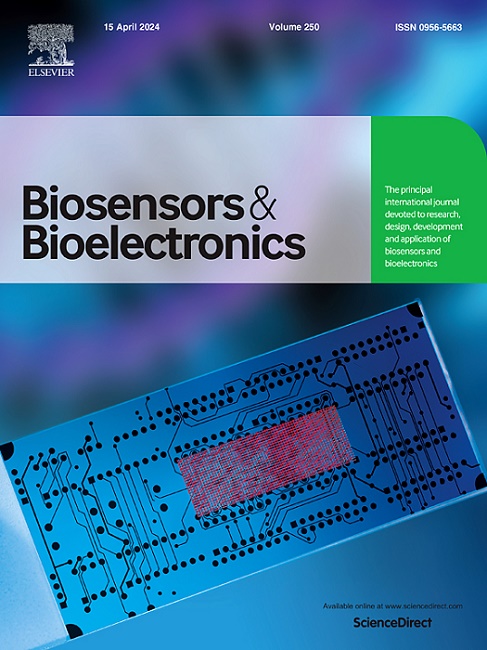Electric field-induced alignment of Ag/Au nanowires for ultrasensitive in situ detection of Interleukin-6
IF 10.7
1区 生物学
Q1 BIOPHYSICS
引用次数: 0
Abstract
Interleukin-6 (IL-6) is a key parameter and critical role in cancer progression. However, for detection of IL-6 in colorectal cancer diagnosis, developing a sensitive biosensor is necessary and very important. In this paper, to enhance the sensitivity of IL-6 electrochemical biosensor, the electric field was used to orient arrangement of silver nanowires (AgNWs) to be free-standing AgNWs electrode. Gold nanoparticles (AuNPs) were electro-reduced around the surface of each AgNWs to solve the rapid oxidization problem of the AgNWs at very low potential (<70 mV) during the electrochemical detection. Oxidation peak current of the free-standing AgNWs/AuNPs electrode only decreased by 5% after 500 scanning cycles, while the free-standing AgNWs electrode without AuNPs decreased by 90.7% after 8 CV scanning cycles. The oxidation peak current of free-standing AgNWs/AuNPs electrode was 500 times of bare electrode. This biosensor showed a wide linear range from 0.001 ng ml−1 to 100 ng ml−1 and a low detection limit of 0.322 pg ml−1 for IL-6. In the end, IL-6 secreted by Caco-2 cell was detected by the fabricated biosensor which integrated into the gut-on-a-chip. IL-6 secretion achieved 11.3 pg ml−1 during 10-days culturing.

电场诱导的银/金纳米线排列,用于超灵敏原位检测白细胞介素-6。
白细胞介素-6 (IL-6)是癌症进展的关键参数和关键作用。然而,对于IL-6在结直肠癌诊断中的检测,开发一种灵敏的生物传感器是必要的,也是非常重要的。为了提高IL-6电化学生物传感器的灵敏度,本文利用电场对银纳米线(AgNWs)的排列进行定向,使其成为独立的AgNWs电极。在每个AgNWs表面周围电还原金纳米粒子(AuNPs),以解决AgNWs在极低电位(-1至100 ng ml-1)和IL-6低检测限(0.322 pg ml-1)下的快速氧化问题。最后,利用集成在芯片上的生物传感器对Caco-2细胞分泌的IL-6进行检测。培养10天,IL-6分泌达到11.3 pg ml-1。
本文章由计算机程序翻译,如有差异,请以英文原文为准。
求助全文
约1分钟内获得全文
求助全文
来源期刊

Biosensors and Bioelectronics
工程技术-电化学
CiteScore
20.80
自引率
7.10%
发文量
1006
审稿时长
29 days
期刊介绍:
Biosensors & Bioelectronics, along with its open access companion journal Biosensors & Bioelectronics: X, is the leading international publication in the field of biosensors and bioelectronics. It covers research, design, development, and application of biosensors, which are analytical devices incorporating biological materials with physicochemical transducers. These devices, including sensors, DNA chips, electronic noses, and lab-on-a-chip, produce digital signals proportional to specific analytes. Examples include immunosensors and enzyme-based biosensors, applied in various fields such as medicine, environmental monitoring, and food industry. The journal also focuses on molecular and supramolecular structures for enhancing device performance.
 求助内容:
求助内容: 应助结果提醒方式:
应助结果提醒方式:


